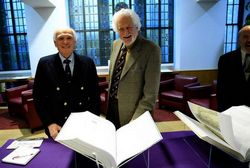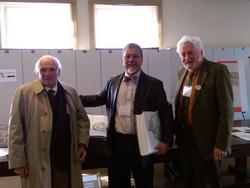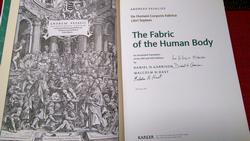Andreas Vesalius opus magnus was the creation and the publication of his book “De Humani Corporis Fabrica, Libri Septem" (Seven books on the structure of the human body). This book was published on May 26th, 1543 by the printing press of Johannes Oporinus.
Much has been said and written about this book and the influence of Vesalius’ work on scientific thinking, the scientific method, and the displacement of dogmatic thinking based on the works of the ancient Greeks and Galen of Pergamon (129AD - 200AD) for a different view of the construction of the body based on direct and empirical observation.
Unfortunately, because of Vesalius’ following of Erasmus’ teachings on Latin, the book was written in a very difficult and circumvoluted language which made it difficult to understand. In addition, the book was very expensive for the times, with an estimated maximum printing of 600 copies.
Were it not for the images and the captions, as well as the many plagiarized versions of the Fabrica in different languages, Vesalius opus magnus would have been lost to history. Harvey Cushing wrote in his Vesalius bio-bibliography of 1943:”As a book, the Fabrica has been probably more admired and less read than any publication of equal significance in the history of science”.
Although several attempts have been done to translate the Fabrica, most of the works have been incomplete, or have tried to paraphrase or correct Vesalius’ words, leaving us with a watered-down image of the author and his intent.
In 1993 Drs. Daniel H Garrison and Malcom H. Hast began a collaboration to translate the Fabrica of Vesalius. The 20- year story of how they obtained federal grants, discussed the translation, found a publisher, scanned and improved on the original images of the Fabrica, and how they even worked with Christian Mengelt to create a new typography for an annotated new Fabrica, was part of their presentation on the interdisciplinary symposium “Vesalius and the Invention of the Modern Body” hosted by the St. Louis University and the Washington University February 26-28, 2015.
This annotated new Fabrica is a translation of the 1543 first edition with comments on the 1555 second edition and it also includes passages and comments from a heavily edited 1555 second edition that has side margins comments and corrections now certified to be in Vesalius’ own handwriting. This book has been speculated to have been Vesalius’ personal copy and probably the basis of a potential third edition. This particular book is now known as "Vesalius' Annotated Fabrica"
The "New Fabrica" was published in 2013 by Karger Publishing, a company based in Basel, Switzerland, the same city where the original Fabrica was published in 1543. The ISBN is 978-3-318-02246-9. Only 948 books were published and it has now been sold out. Because of the demand, an original is now considered a rare book.
Daniel H. Garrison received his degrees from Harvard (A.B. Classics, 1959) and Berkeley (PhD Comparative Literature, 1968). He was a member of the Classics Department at Northwestern University from 1966 until his retirement in 2010.
Malcolm H. Hast is Professor Emeritus of Otolaryngology – Head and Neck Surgery – and also past Professor of Cell and Molecular Biology (Anatomy) at Feinberg School of Medicine of Northwestern University. He is Fellow of the American Association for the Advancement of Science as well as Fellow of the Anatomical Society (UK) and a Chartered Biologist and Fellow of the Society of Biology (UK). He is also a recipient of The Gould International Award in Laryngology and a NATO Senior Fellowship in Science.
Personal note: I am honored to have met both Drs. Garrison and Hast at the symposium, shared some of the stories behind the new Fabrica and have them sign my own copy of this incredible book. Dr. Miranda
Sources:
1. "A Bio-blibliography of Andreas Vesalius" Cushung, H. 1943 Saunders






